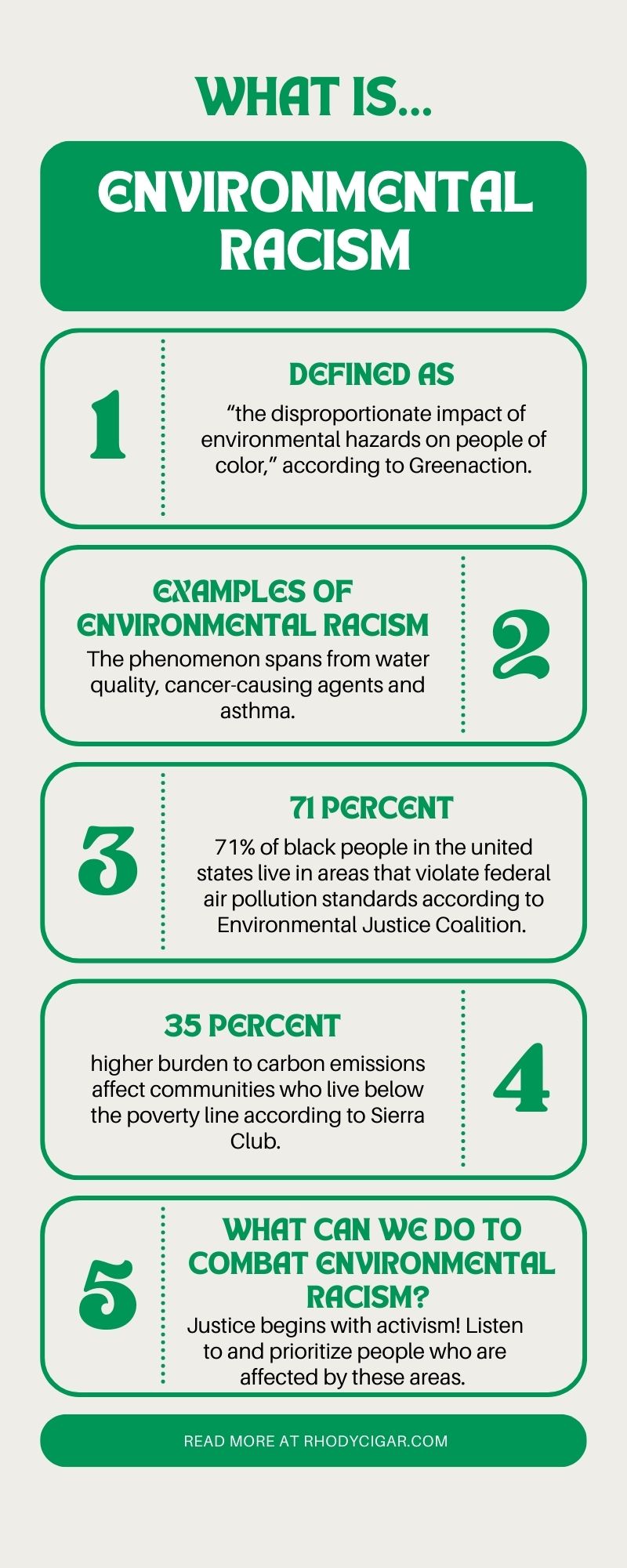Disproportionate impacts of environmental hazards on people of color
Graphic by: Maddie Bataille | Photo Editor
In honor of April being Earth Month, professors at the University of Rhode Island discussed the topic of environmental racism and justice.
The non-profit organization, Greenaction, defines environmental racism as “the disproportionate impact of environmental hazards on people of color,” explaining environmental justice is a movement in response to combating this social issue.
This form of systemic racism arises when communities are segregated and then environmental problems are placed next to low-income neighborhoods, according to political science professor Aaron Ley.
Amelia Moore, associate professor of marine affairs, focused the topic of environmental racism more directly toward ecological justice, pertaining to communities that have been driven off their land by the interests of others.
“Who are we protecting this land for? Who is going to be able to access these spaces?” Moore said. “Right now, a lot of places are being protected for elite tourists.”
She emphasized that it was important to recognize the relationships that different communities have with the land.
Much of the country’s natural land has been claimed by groups of people who seek profit at the expense of the communities that previously lived with it, and these groups of people are most often people of color.
“To imagine an ecosystem is only healthy without people is not a universally idea,” Moore said.
For URI specifically, the Narragansett Tribe has been acknowledged as the people that are paid tribute, those who previously lived on and stewarded the land the University now resides on.
“There is a large conversation that nature is not considered to be a space for African Americans, that these are urban problems,” she said.
The history of segregation and exclusion affects both the land and the people who have inhabited it over time.
In many situations, communities of color have been driven off rural land and encouraged toward urban areas, where many issues of environmental justice present themselves.
For Ley, he spoke largely on marginalized groups in urban areas, rather than rural areas. These inequities have been prevalent since the Great Depression, according to a study conducted by the School of Environment and Sustainability at the University of Michigan.
After the New Deal was implemented, communities were segregated by income to allow for white families to move into suburban developments whereas marginalized communities were appointed to urban areas. This was called Redlining. The federal government created color-coded maps to determine which areas were most risky for investment, those being minority communities based on racial biases, according to Ley.
These urban areas are now subject to higher risk from heat waves, landfill pollution, industrial pollution, and other climate hazards that expose these individuals to higher health risks. Ley explained that with communities placed next to industrial zones, diesel emissions increase, air quality diminishes, demand decreases and property values decrease, therefore attracting lower-income buyers. Large landfills and recycling plants allow for any heavy rains to run through these areas and litter these urban communities with polluted runoff.
Much of this environmental discrimination stems from previously implemented legislation that separated communities by location in urban areas, which makes this a systemic issue. Those who are able to pay more for housing are ultimately protected from disproportionate environmental factors and the resulting health effects.
Particularly in cities, populations experience an urban heat island effect, where there is more concrete and fewer green spaces, said Ley. This ultimately raises city temperatures from rural ones as concrete absorbs heat much differently, keeping it much closer to the ground. With this rise in temperature, climate change disproportionately exposes urban communities to these heat issues that require spending more money on cooling methods. These areas may ultimately rely on cooling centers during heat emergencies, such as fire departments and libraries, Ley said.
“They’re paying more to cool their houses, houses may be more humid which causes more mold to develop in their houses, so then they’re exposed to very severe health conditions,” Ley said. This zoning and lack of environmental laws can target marginalized communities who cause major problems to a minority of people that are impacted.
These issues are also seen when natural disasters strike lower-income areas, such as Cuba after Hurricane Ian. The island experienced a nation-wide blackout which left 11 million people in the dark and many without water, according to BBC News.
With areas that cannot put extra funding into infrastructure and preventative supplies, their communities experience disproportionate environmental risks.
Locally, bills have been passed to repurpose contaminated areas into industrial zones, which poses economic benefits but still exposes surrounding communities to harmful emissions.In order to exercise activism for environmental justice, individuals can reach out to the People’s Port Authority to get involved. For more information about climate justice in different environments, students can turn to OurClimate.us. Additionally, information about land justice for indigenous communities can be found at Landback.org.





